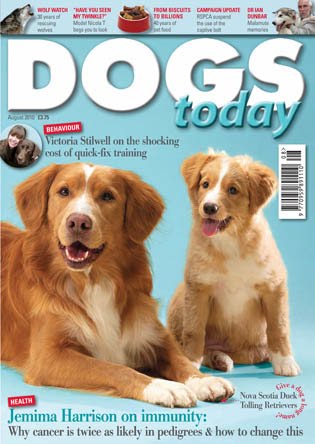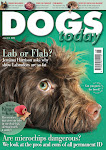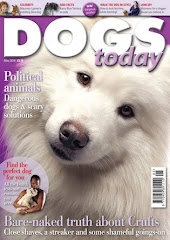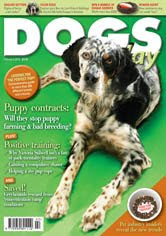I've decided we'll be doing another feature next time!
Do you have strong view on the following? (I'm suspecting yes!)
Please tell me what dogs you own, what you currently feed and your responses to the following! Or if you are a petfood professional - please introduce yourself - don't be shy!
- Can you get really good results on a top-notch prepared food as opposed to a cheap one - or do you believe you have to feed raw? (Anyone got any data or anecdotes to back their hunches up? Any dogs living long and healthy lives on a particular regime?)
- Can dogs digest carbs? Why not? And if yes, what are the best carbs and why? Why do we have carbs in dog food?
- Should we really be trying to feed the dogs as if they were wild animals now they don't do nearly so much exercise these days? How much protein is ideal? Why? Can you have too much?
- And is the prey diet really the one to replicate? Haven't our pet dogs evolved? After all they've been living alongside us for some say 120,000 years and sharing our cooked food for much of that time?
- Don't we want longevity for our pets not a short life of high energy, fighting for survival and the right to reproduce? Are some people just a little bit in love with the romance of the wild dog philosophy rather than the wild dog reality?







11 comments:
From Claire M
The more I read other people's comments on the feeding debate, the more fascinating I find this topic! Having seen Orijen dry dog food mentioned quite a few times recently, I visited their website to find out more - and this led me on to the website Dog Food Analysis.com... definitely worth a look.
Edited by site admin
Edited post from Jonathan Self...
Hello. I feel I must start by explaining that I am one of the founders of a new ethical, raw dog food company called Darling's. I will include our website at the end BUT I want to make it clear that we will provide free help and advice to anyone interested in switching theirs dogs to a raw diet.
www.darlingsrealdogfood.com
Jonathan - can you mould your comments to address the specific points in the blog? Long posts - more like stand alone articles - won't really work.
Cheers
Beverley
Dear Beverley
Sorry. I was only trying to be helpful by giving you lots of information all of which was pretty relevant to your questions.
Best wishes
Jonathan
Hello Beverley
Without wanting to sound rude, I'm really disappointed that you felt you couldn't show all of my comment. I thought it provided evidence that there is a HUGE variation in the quality of dry dog foods available - and that it is very difficult for owners to make an informed choice based on the very limited information on a label. I am suprised that you are worried about offending food manufacturers, given your very brave stance on the breeding of pedigree dogs. Perhaps you could explain your decision?
Best Wishes, Claire x
Interesting debate! I think pet owners should be free to choose what to feed their pets. It all gets a bit hairy when advocates from both sides start slinging mud at each other and each side claiming the moral high ground!
Personally I think either raw or not is fine as long as you feed a really high quality food from either camp.
If you feed a good quality wet food then just because this has been cooked does not mean it is worse than feeding raw. A Lily's Kitchen tin for example has 60% real meat, 18% real vegetables, herbage and 3% brown rice (unless its a grain -free recipe).
When Lily was going through her bad skin phase and refusing all shop-bought food, I tried her on raw food a few times, but she was not interested at all - which is why I set up Lily's Kitchen.
We have plenty of customers who feed raw and then use our tins as a back up when they just want to pull something out of the cupboard.
The problem is that most wet foods do not include real food - mainly flavourings and fillers..
For dogs who are just fed dry food, it is so important that it is a good quality dry food as again most dry foods have very little good nutrition in them and can have masses of artificial additives. You really do have to study the label!
Oil content is too high on most dry foods and the new trend for 'grain free' dry foods can mean that the protein content is sky high too and the concern is that this can cause organ problems in later life.
Where the carbs come from is really important too - they should not just come from grain, but also from fruit and vegetables as well as seeds and pulses.
When owners switch to a really good quality food it makes such a difference - the most noticeable thing is the smell of your pet's coat. Gone is the greasy smell - the coat smells lovely - the sweet smell of toast and fresh grass combined!
Henrietta from Lily's Kitchen
As with all diets the main thought process has to be common sense.
A varied diet of fresh foods containing natural protein, fibre, vitamins and minerals is the ideal source of the nutritional needs of dogs.
Like ready meals, processed convenience foods for us, manufacturers produce products that suit consumers and for my part, I produce products that suit dog owners who care and think about the positive benefits of diet for themselves and their dogs.
Raw protein is easily the best form of digestible protein for dogs and this is a contributing reason as to why dry kibbles have failed to deliver the complete diet that everyone was sold for many years.
Fresh meat, usually pre-frozen is best, with raw vegetables, fruits, oils and bones provides the real basic diet now easily termed BARF.
NOW it’s very easy to find pre-made BARF complete diets in specialist pet stores such as Pets at Home and Nature's menu released such diets this year, after over 30 years of preparing raw foods for pets.
Raw food is safe and convenient when sourced from registered / professional producers who have taken the time to examine the meat supplies, source quality ingredients and look at the nutrition required from a real nature dietary approach.
Don't imagine that you simply grab some meat and bones from the butcher and throw in some veg because it’s that dietary approach that you will be told by the main stream manufacturers is why BARF should be avoided.
They profess to be the ones looking after diet for you and your dogs but the commercial demands of processed pet food can never deliver real nature diets unless you choose a specialist brand who invests in ingredients, simple processing and reliable nutrition based upon diet rather than price or convenience.
Natures menu leads the way in raw complete BARF diets and now cold filled precooked products in cans and pouches.
Be careful to select a brand that is made by a manufacturer and not simply a marketing company as like the large producers they are sometimes looking at the cost and don't have the manufacturing support to view raw materials and diet.
There are many good British companies working hard to deliver good natural pet foods and I hope the consumer makes the right choice in 2010 for their pet and supports these hard working companies.
Real raw or naturally made pre cooked products have positive behavioural and nutritional effect and I have millions of satisfied consumers who can support these claims.
With 30 years experience in pet food and being the largest producers of raw diets in Europe I feel qualified to comment.
Thanks to Beverley and everyone at Dogs Today for raising these issues.
Craig Taylor
Managing Director
Natures menu Petfoods
I have been feeding my eight year old SBT for approx two years on Orijen, previously he was plagued with problems with his cruciate ligament, he would spend weeks on limited exercise and Metacalm,but as soon as he was off lead again, being his normal boingy self, the ligament would "go", but about 6 weeks after being fed Orijen, he stopped having any problems with his leg, and has continued to be problem free. I believe that the increased protein levels in Orijen gave his body the much needed means to heal the ligament itself. He'd previously been on a high carb diet,once I started researching food myself and stopped believing the manufacturers sales pitch, I had the means to feed my dog what was good for him, rather than what was good for the manufacturers profit margin.
Post a Comment